Argentina have been one of the favourites for Copa América 2024 glory from the outset of this year’s tournament, so it comes as no surprise that we see them in the final.
Their opponents, Colombia, on the other hand, entered the competition with far less expectation behind them that they’d reach this point, with their quality performances coming as a little bit more of a surprise, but with their place in the final just as deserved as Argentina’s.
These two sides have performed to a high level throughout the tournament, with both featuring in a counterpressing analysis piece we produced at the end of the group stage, which focused on the competition’s top performers. Their levels in counterpressing or in any other aspect of their respective games haven’t dropped at all during the knockout phase, hence their inclusion in this year’s continental showcase.
This tactical analysis piece in the form of a tactical match preview provides analysis of critical aspects of both teams’ respective tactics and where either side can make gains from a tactical perspective in the Copa América 2024 Final.
Predicted lineups
Lionel Scaloni’s world champions have primarily lined up in a 4-4-2 shape during Copa América, with Emiliano Martínez between the sticks — La Albiceleste’s only ever-present player throughout this tournament with no outfielder playing every minute or even starting every game.
Nahuel Molina has mainly played at right-back and is likely to remain in that position for the final alongside Cristian Romero at right centre-back and Lisandro Martínez at left centre-back. Meanwhile, Nicolas Tagliafico has been Argentina’s main left-back throughout the competition.
Rodrigo de Paul (right) and Enzo Fernández (left) are the likely starters in central midfield, with Ángel Di María (right) and Alexis Mac Allister (left) playing on the wings.
Lionel Messi will start up front alongside either Júlian Álvarez of Manchester City or Lautaro Martínez of Inter — with the former scoring a crucial goal in La Albiceleste’s semi-final win over Canada and the former remaining the competition’s top goalscorer. However, all of his goals came in the group stage.
Given his semi-final performance, we’ll give Álvarez the nod, but Scaloni could, realistically, go either way on that call.
In possession, they’re more likely to appear in a 4-3-3 with lots of central movement and rotations between Messi and the midfield trio of Mac Allister, De Paul and Fernández, as we’ll discuss in greater detail later.
As for Néstor Lorenzo’s side, Colombia have primarily lined up in a 4-3-1-2 shape during Copa América with both goalkeeper Camilo Vargas and right centre-back Davinson Sánchez featuring for every minute.
In addition, James Rodríguez (attacking midfield), Richard Ríos (central midfield), Jhon Arias (right central midfield) and Luis Díaz (left forward) have started every game and will likely remain in the starting XI for the final.
Right-back Daniel Muñoz has also started every Copa América game for Colombia up to this point. However, after his semi-final red card, he will be suspended for the final, meaning Santiago Arias is likely to play at right-back instead.
Alongside Sánchez at centre-back, we’ll likely see Carlos Cuesta on the left, while Johan Mojica has been the primary starter at left-back throughout the tournament.
Jefferson Lerma will probably start at left central midfield, completing the diamond quartet in the middle of the park, as Jhon Córdoba likely partners Díaz up front, completing Los Cafeteros’ starting XI.
Transitions
While Colombia found themselves defending deep and counterattacking a lot in the semi-final, they played the entire second half of that game with 10 men due to Muñoz’s sending off in first-half stoppage time.
For the majority of the tournament, Colombia have been quite possession-dominant, retaining 49% of the ball in their group stage draw with Brazil, for instance, and keeping an average of 54.4% over the course of the tournament — fifth-highest.
Argentina, similarly, have been very ball-dominant as you’d expect, with an average of 60.4% possession thus far during the tournament, trailing only Brazil, who were knocked out by Uruguay on penalties in the quarter-final.
For both Argentina and Colombia, as is typical with ball-dominant teams, transitional defence has been a staple of their tactics throughout this tournament, with both sides counterpressing aggressively both as a form of defence in that it has protected their weakened backline from direct attacks on the counter but also as a form of attack, as high regains in transition can allow them to hit the opposition’s backline when not so settled via a quick counter of their own.
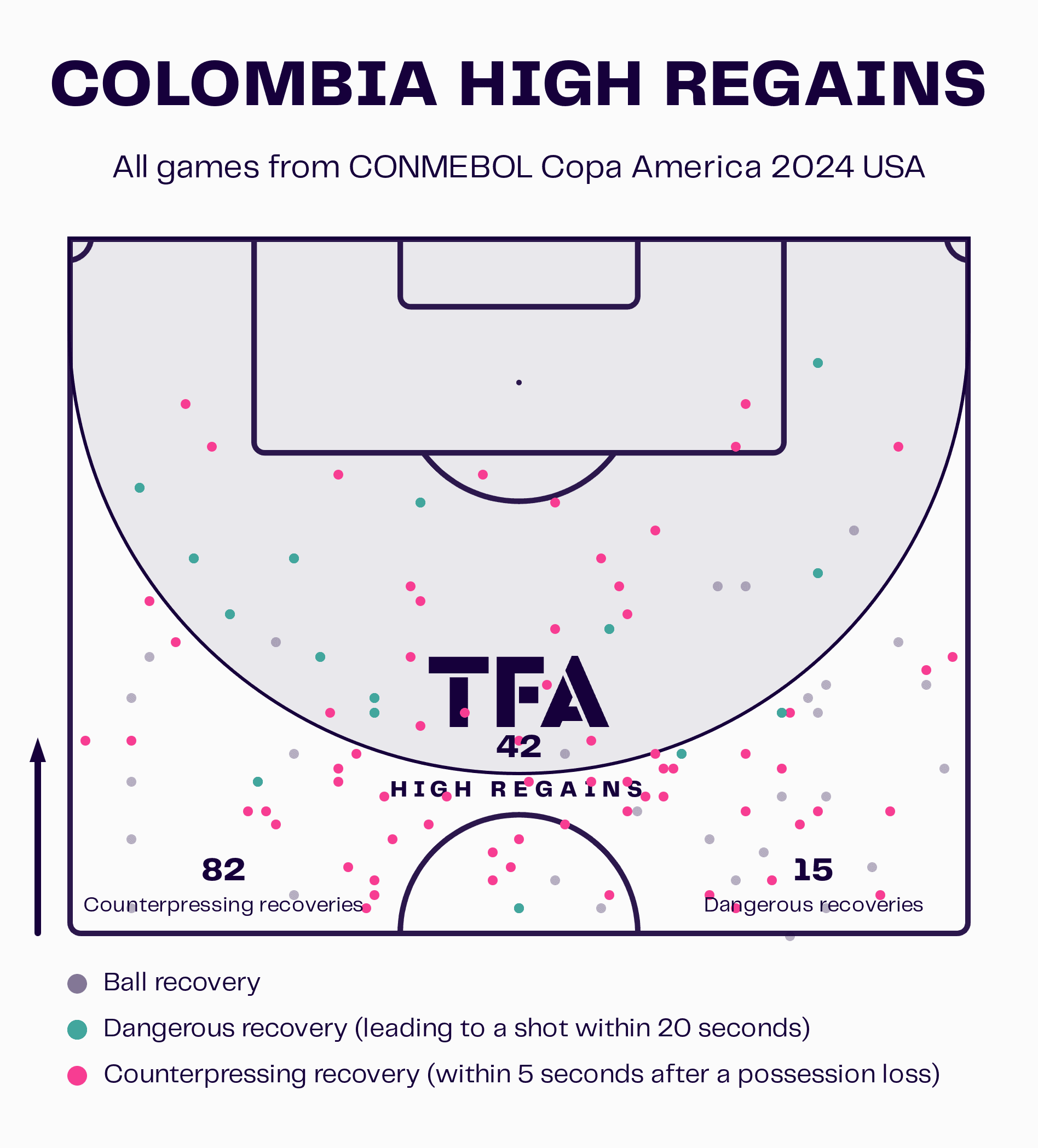
At this point in the tournament, Colombia has completed 82 counterpressing recoveries, 42 high regains, and 15 dangerous recoveries, averaging 16.4 counterpressing recoveries, 8.4 high regains, and 3.0 dangerous recoveries per match.
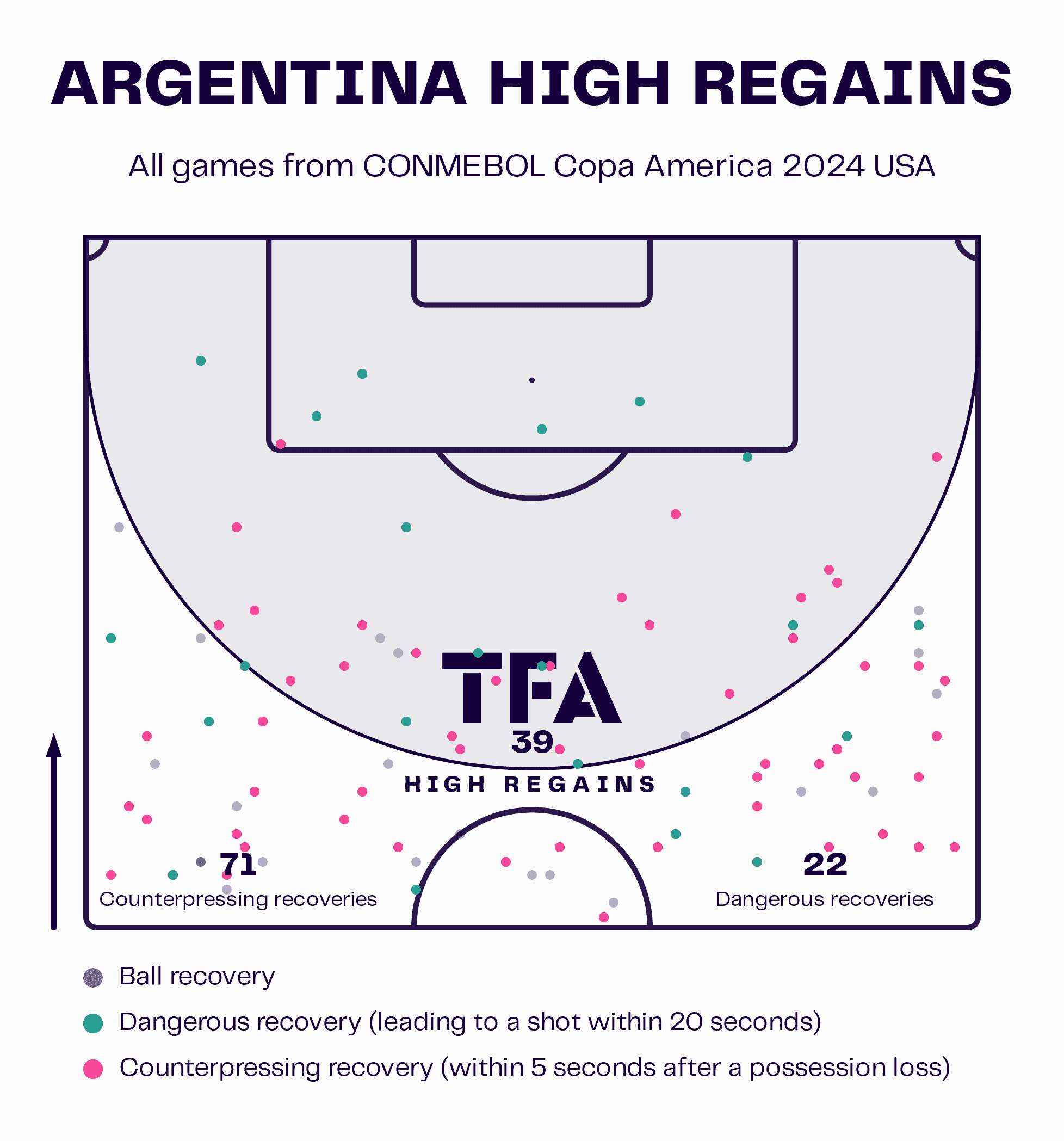
On the other side, Argentina have completed a total of 71 counterpressing recoveries, 39 high regains, and 22 dangerous recoveries in Copa América 2024 to date, with those stats averaging out to 14.2 counterpressing recoveries, 7.8 high regains and 4.4 dangerous recoveries per match.
Comparing the two, while Colombia have been making more counterpressing recoveries and marginally more high regains, Argentina have been better at converting their high turnovers into goalscoring opportunities.
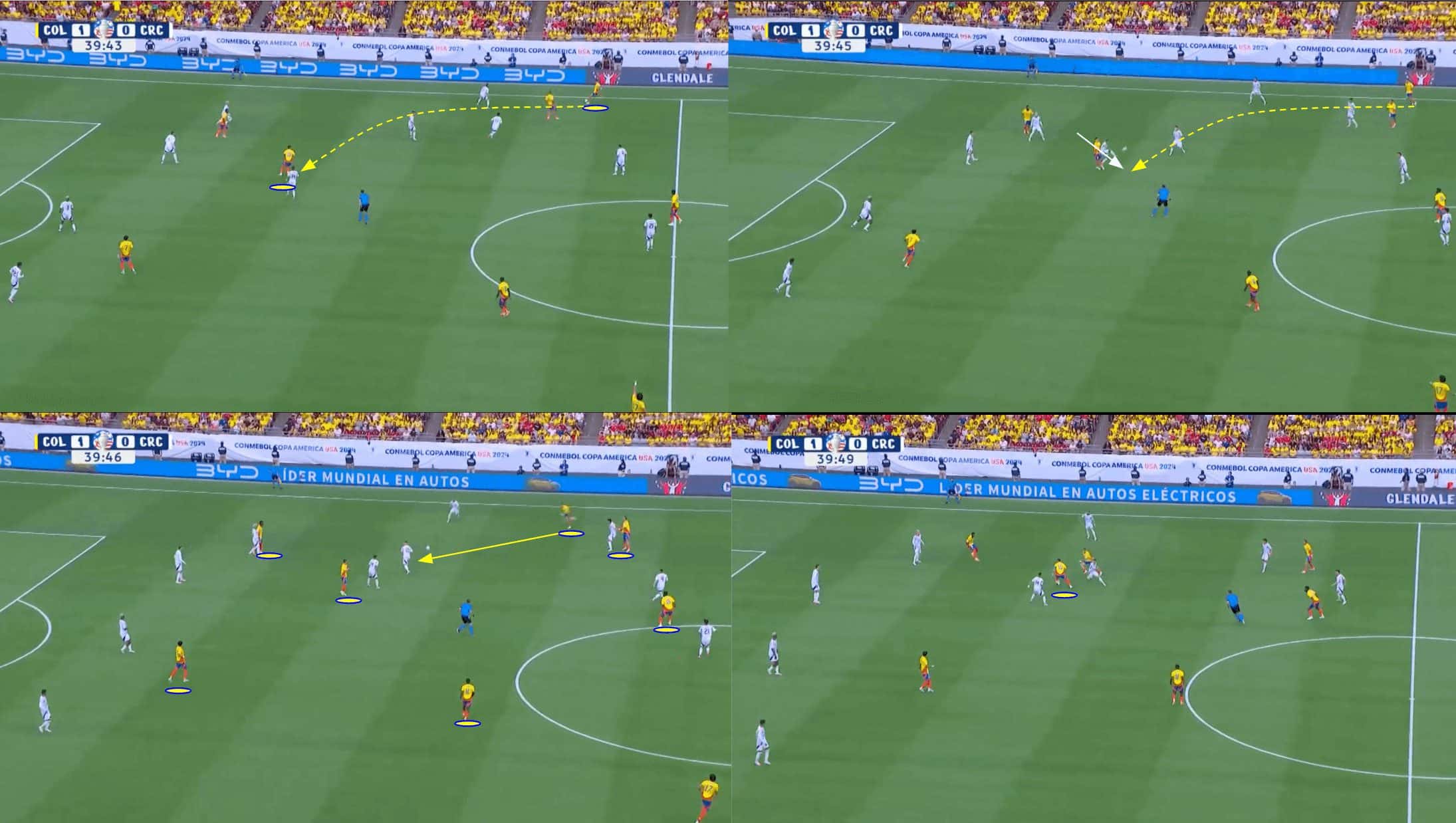
For a more detailed analysis of both these sides’ counterpressing tactics during this tournament, we recommend checking out our analysis piece titled “Copa America 2024 Tactics: The counterpressing secrets of the top group stage performers—scout report,” which analyses both La Albiceleste and La Cafeteros at that point in the competition, as well as Marcelo Bielsa’s Uruguay.
To sum up, in addition to what we’ve already said, Colombia tend to add one body from deep to a more advanced position while keeping bother bodies already in the targeted area where they are, like we see in figure 3 with the example of the right-back bombing forward after a loss of possession near the ‘10’, leading to a Colombian overload in this area and another quick turnover just inside the opposition’s half for Néstor Lorenzo’s side to capitalise on.
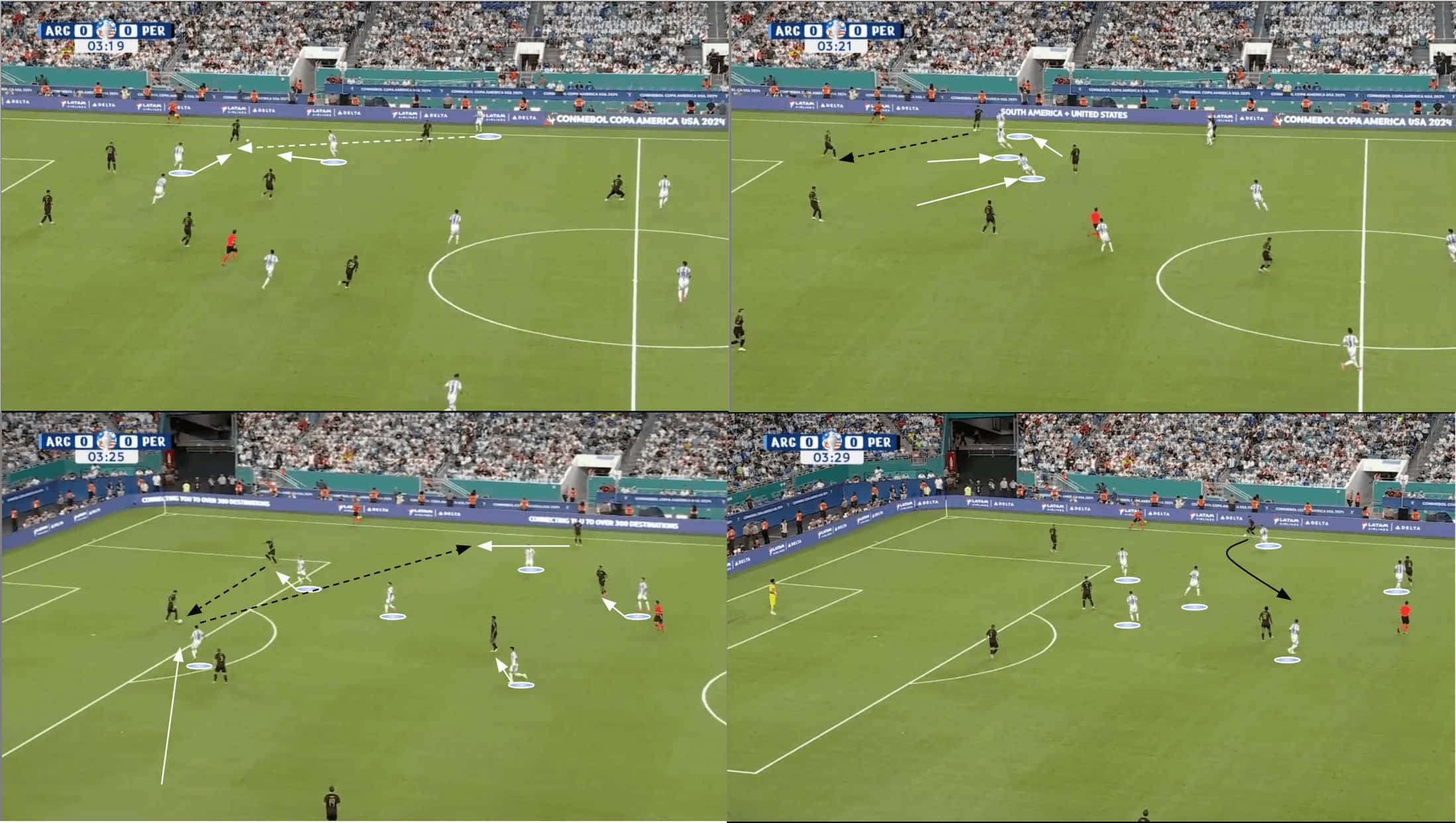
On the opposite side, it’s been common to see Scaloni’s side essentially cage the opponent in on a particular side of the pitch in their counterpressing, with the ball-far winger coming over in the bottom-left picture of our figure 4 example above to pin the opposition into that deep left-sided position where Argentina will be able to use the sideline as an extra defender and press the ball-carrier aggressively while marking all nearby passing options out of the game.
In the example above, the opponent does well to dribble past the player pressing him into midfield and escape the pressure, but there have been plenty of times during this tournament when Argentina have forced high turnovers as a result of this counterpressing tactic, giving the creative players like Messi, Mac Allister, Dí María and Fernández a chance to hit the opposition’s backline when it’s less prepared for their quality, hence the high number of dangerous recoveries they’ve generated.
Argentina in-possession, Colombia out-of-possession
While both of these teams have been quite possession-heavy during Copa América, we see Argentina having slightly more of the ball than Colombia in this one. However, it should be nowhere near as one-sided in terms of possession as it was in the semi-final on the Colombian side (38% to Uruguay’s 62%) barring any more unforeseen circumstances like another sending off.
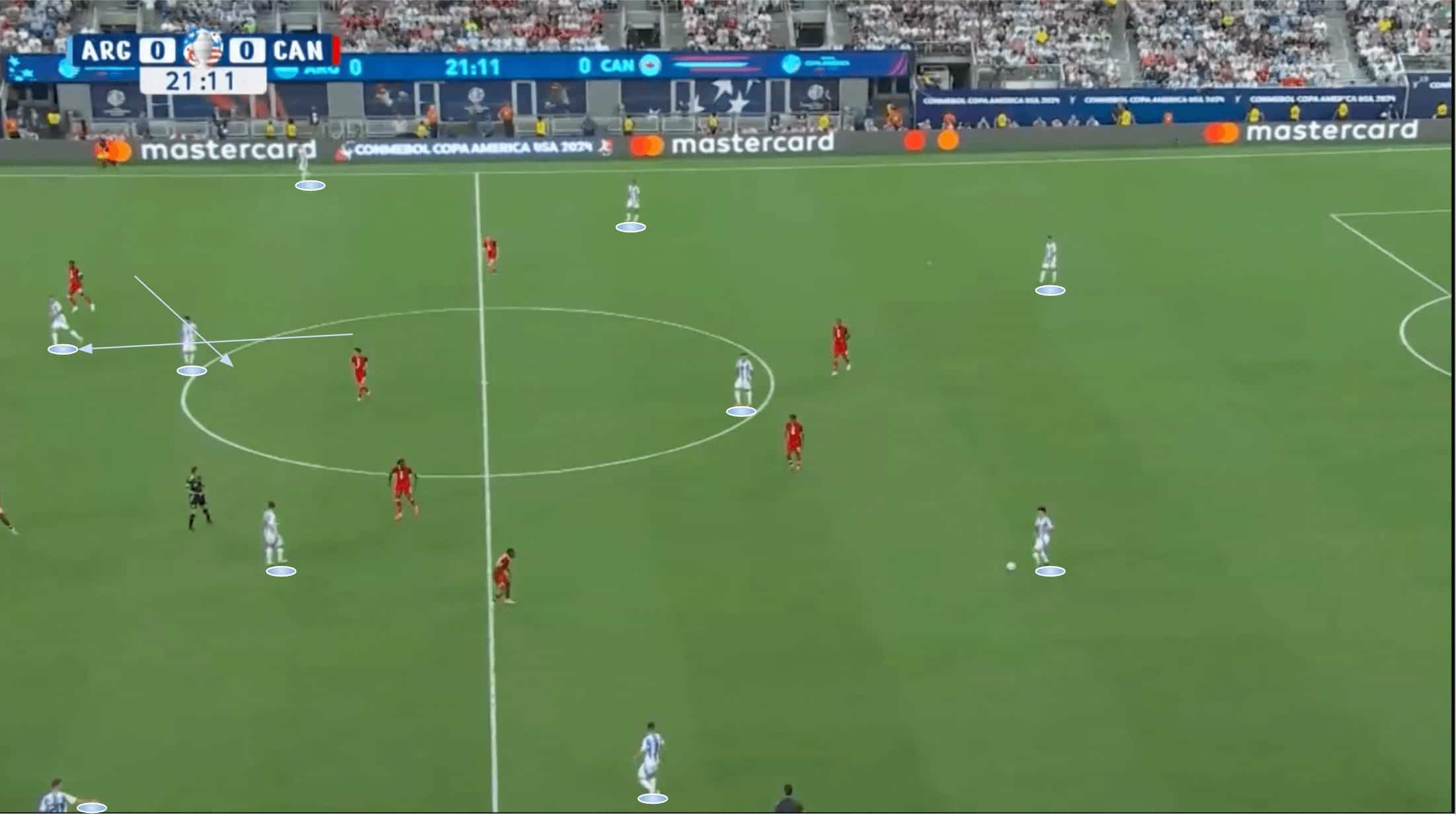
As mentioned earlier, while Argentina defend in a 4-4-2, they tend to attack in a 4-3-3. That 4-3-3 is constantly evolving in the middle of the park, with Messi enjoying lots of freedom to drift around where he likes — often ending up occupying a position that would’ve been occupied, on paper, by another midfielder.
This leads to one of Argentina’s biggest strengths in this tournament — their off-the-ball movement and constant rotations in midfield.
We see an example in figure 5, where Messi has been highlighted just on the tip of the centre-circle inside the opposition’s half, occupying what would’ve been the right central midfielder’s position in this three-man midfield.
As a result, De Paul, the right central midfielder, advances higher, occupying a position in the forward line.
Argentina’s midfield rotations make them quite difficult for the opposition to keep track of and mark, with Canada struggling massively in this regard.
This will be something for Colombia to take note of and prepare for in the final, or else they’ll struggle to prevent Argentina from creating chances via these methods — especially through Messi.
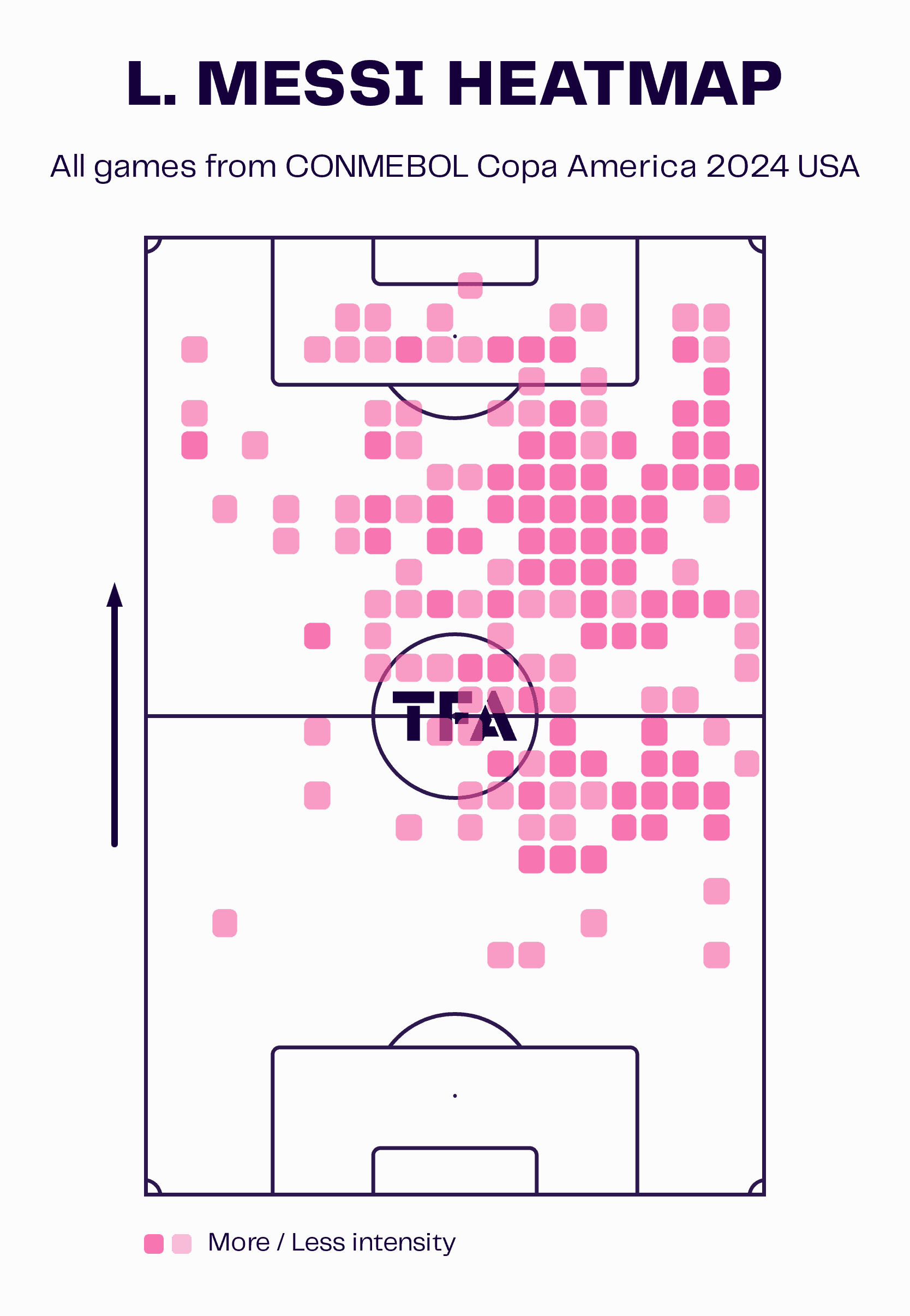
As his heatmap from the tournament so far displays, Messi has been heavily active in the right half-space but has drifted all the way into the centre a fair bit as well as all the way out onto the wing.
Crucially, Argentina have been able to get him involved a lot in those central positions as well as in the box from where he’s taken the majority of his 12 shots in the tournament thus far, generating 1.86xG and scoring once.
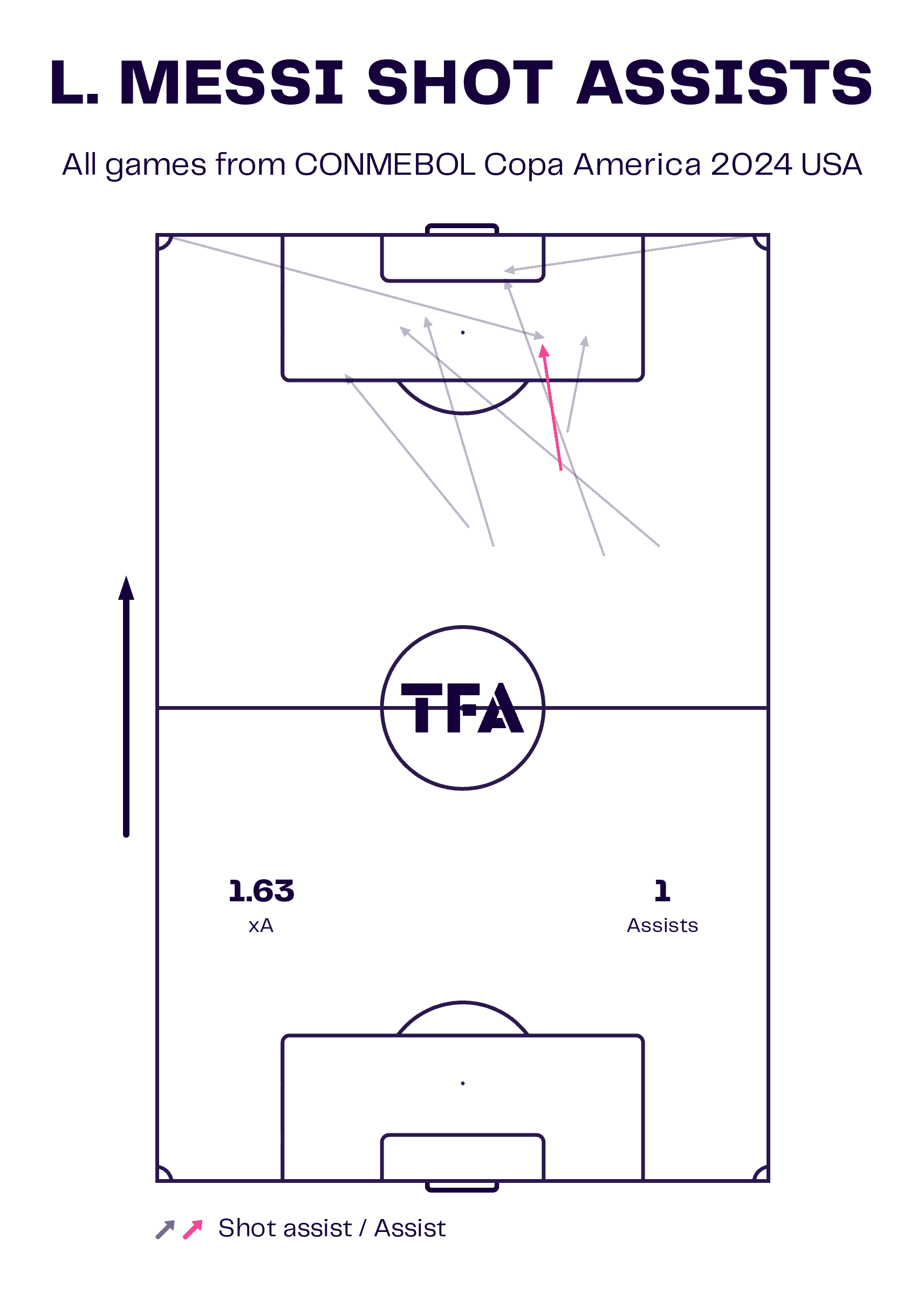
Messi has been Argentina’s chief creator at Copa América, generating 1.63 xA — more than double the value of the next-highest xA in the team, Nicolas Tagliafico’s 0.76.
Again, it’s the right half-space, on that line between the final third and the middle third inside the opposition’s half, where Messi has been most fruitful as a creator in this tournament and where Colombia will need to have defensive preparations in place.
Furthermore, it’s critical to remember that they’ll need to worry about more than Messi. If they focus too heavily on him, they may open up space for the likes of De Paul, Fernández, Mac Allister, Dí María, or, indeed, Tagliafico to hurt them, as has also occurred during this tournament.
So far, Argentina are the best attacking side in the competition in terms of xG, with 10.26 to their name — 9.5 of which is non-penalty xG as figure 8 displays.
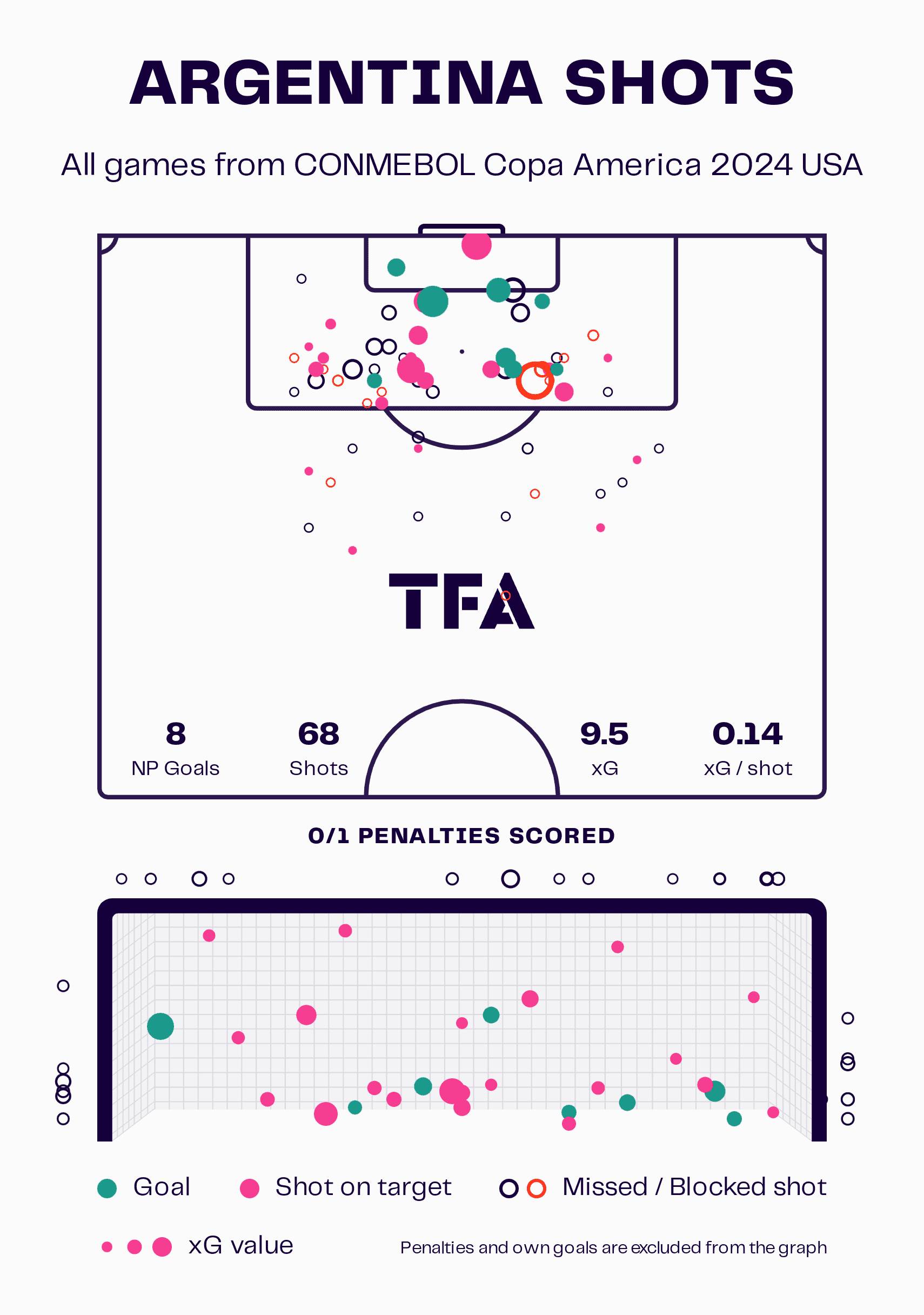
Scaloni’s side have done well to generate lots of chances from high percentage areas, including four which resulted in goals in and around the six-yard box.
At the same time, they’ll be coming up against a Colombia side that has conceded just twice during this Copa América campaign, once from open play. They concede 2.91 xGA—the fourth-lowest of any side in the tournament—allowing opponents to generate 0.062 xGA per shot—the second-lowest xGA per shot of any side in the competition, trailing only Mexico, who were knocked out in the group stage.
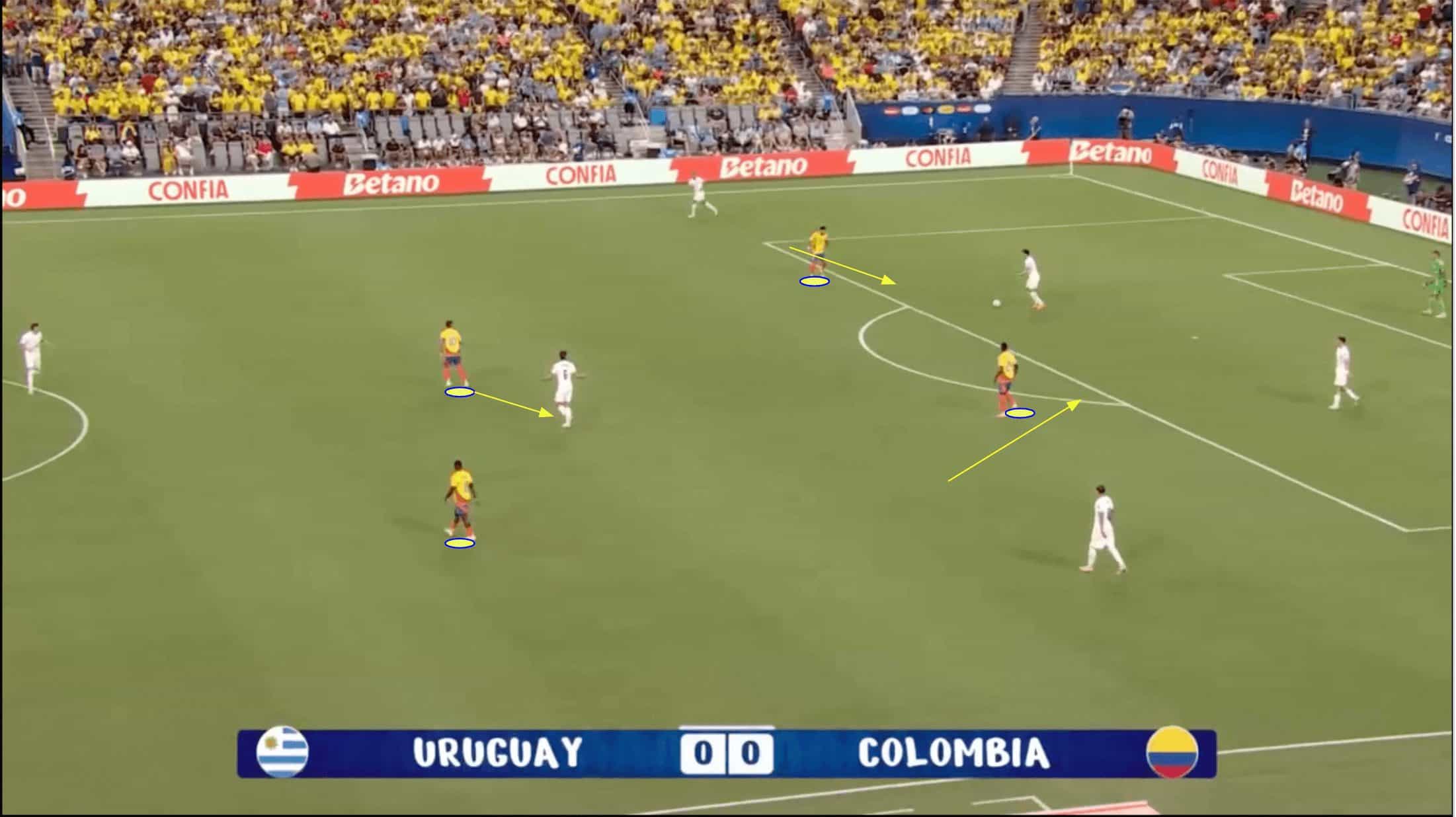
Colombia like to press high, engaging the opponent right from the edge of their box in the build-up phase. Their two forwards within the 4-3-1-2 shape press aggressively while keeping passing options behind them, in wider positions, in their cover shadow as we see in figure 9.
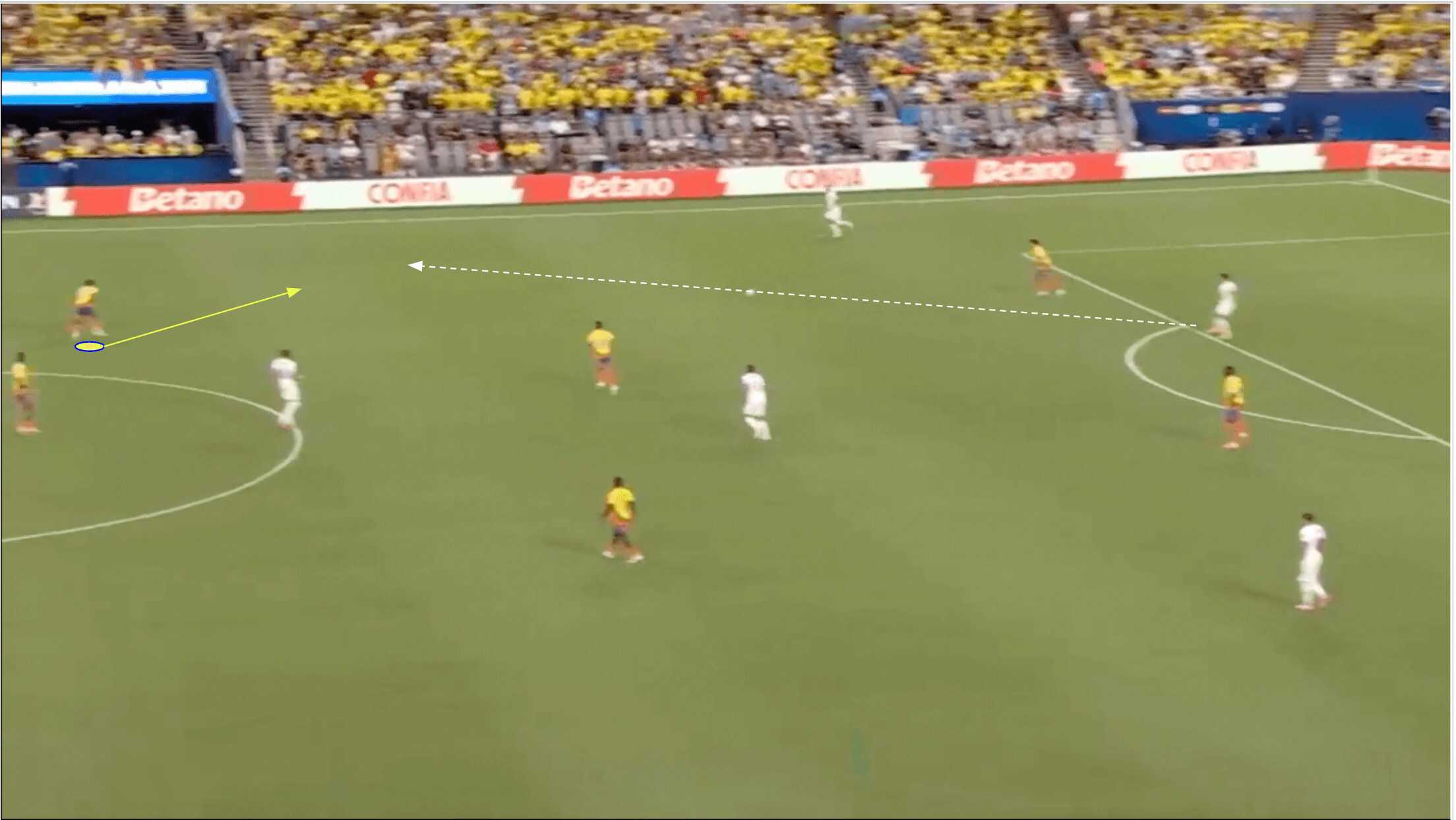
Behind those forwards, the diamond midfield is ready to pounce on any progressive balls that make their way past Colombia’s first line of defence. The ‘10’, Rodríguez, will be marking the opposition’s holding midfielder, while the two wide central midfielders will be ready to press aggressively if any pass beats the forwards, including out to the wide areas as was the case in figure 10.
Expect the midfield to be quite congested in the Copa América Final, with Argentina likely to be forced out wide in the build-up / ball progression phase. There will be interesting battles in those wide areas between Argentina’s full-backs and Colombia’s wide central midfielders, who’ll be shifting over as we see here while the rest of the diamond midfield and forwards move across after them in support and to retain compactness.
This could open up a weakness for Colombia on the ball-far side to switches of play, while Argentina could also find a pathway through centrally thanks to the fast and frequent rotations they’ve been pulling off to a very high level with Messi and co in the centre.
If Argentina can create free bodies via their off-the-ball movement in the centre and those on the ball can pick them out, that could give them enough time on the ball in valuable positions to make something happen and win this game. Suppose Colombia can remain compact, alert and committed in defence at all times. In that case, they may be able to deny Argentina many opportunities for chance creation as they have for all opponents in this competition thus far.
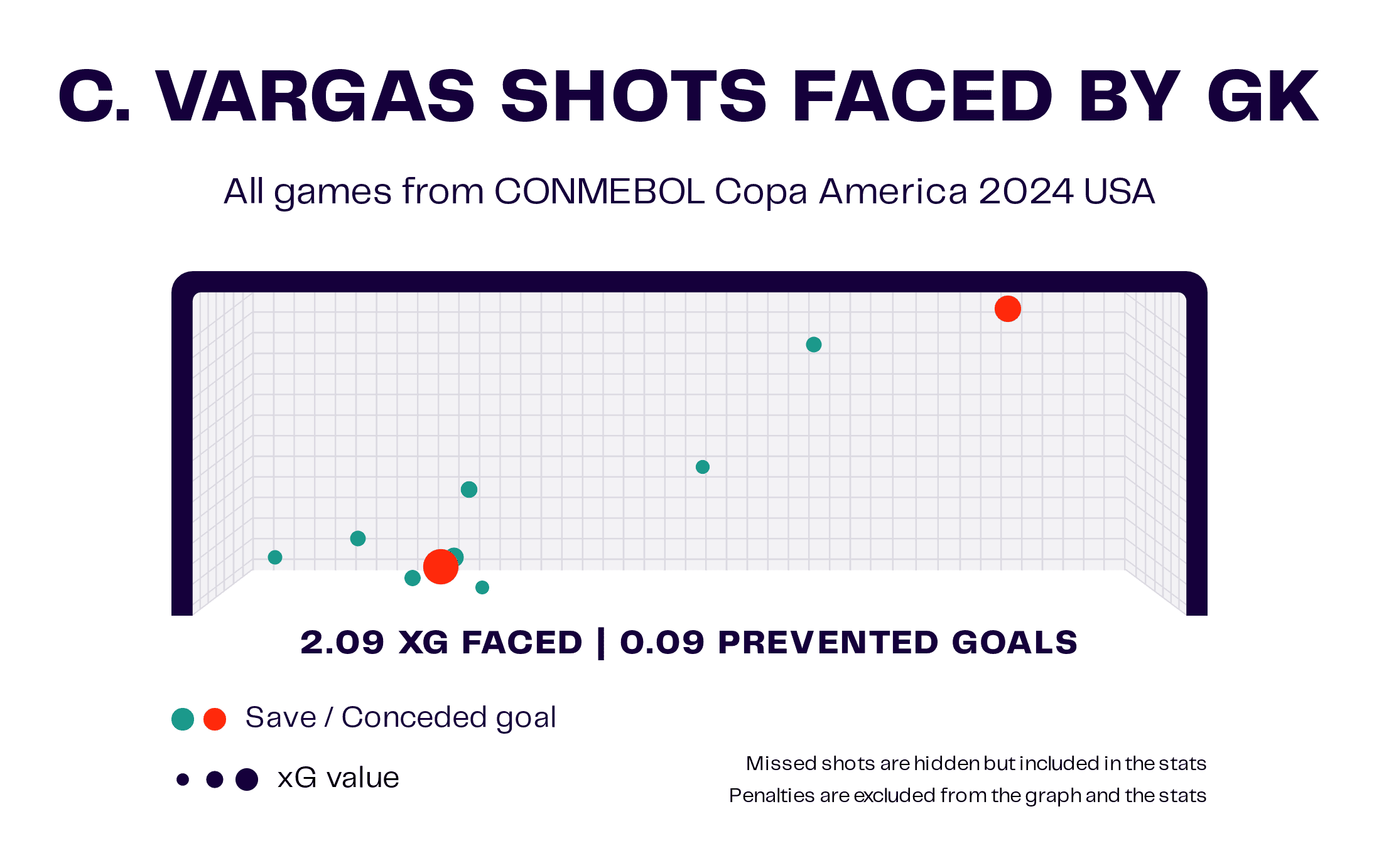
As for the last line of defence, Camilo Vargas has performed about on par with expectations in goal for Colombia during this tournament but hasn’t really been tested much and will face his toughest task of the summer in the final, without question.
From 2.09 xG faced, he’s conceded twice — the two highest percentage chances he’s had to deal with, as indicated by the size of the red dots in comparison to the green, the latter of which corresponds with shots saved.
Colombia in-possession, Argentina out-of-possession
Moving onto Colombia’s approach in-possession and Argentina’s tactics without the ball, while Argentina have generated the most xG of any side in this competition, Colombia are just behind in second place by that metric.
On top of that, Colombia have crucially converted more chances than any other side at Copa América this summer, scoring 12 goals — three more than the second-most prolific side, Uruguay, who they overcame in the semi-final and four more than their opponents in the final, Argentina.
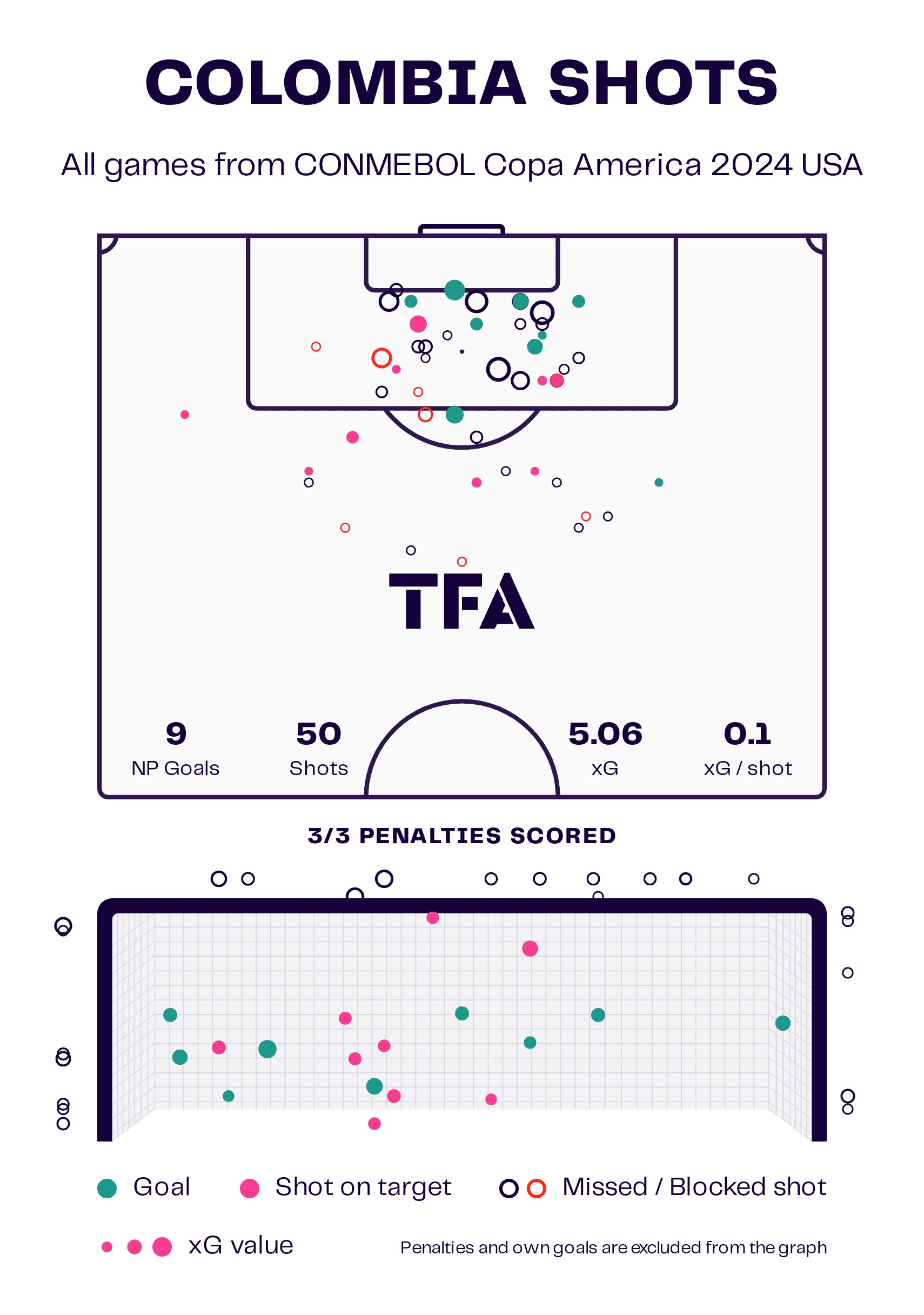
With that said, Colombia have taken and scored three penalties during this competition — two more than Argentina.
Their non-penalty xG sits at 5.06, which is far lower than Argentina’s 9.5, and they’ve generated just 0.1 non-penalty xG per shot, which is far lower than Argentina’s 0.14.
With this in mind, along with Argentina’s superiority in generating chances in transition via dangerous recoveries, we’re seeing that La Albiceleste are clearly the more threatening side in possession, but Colombia still can’t be underestimated in this area, given that they’re still the tournament’s top goalscorers and are very much in the final on merit.
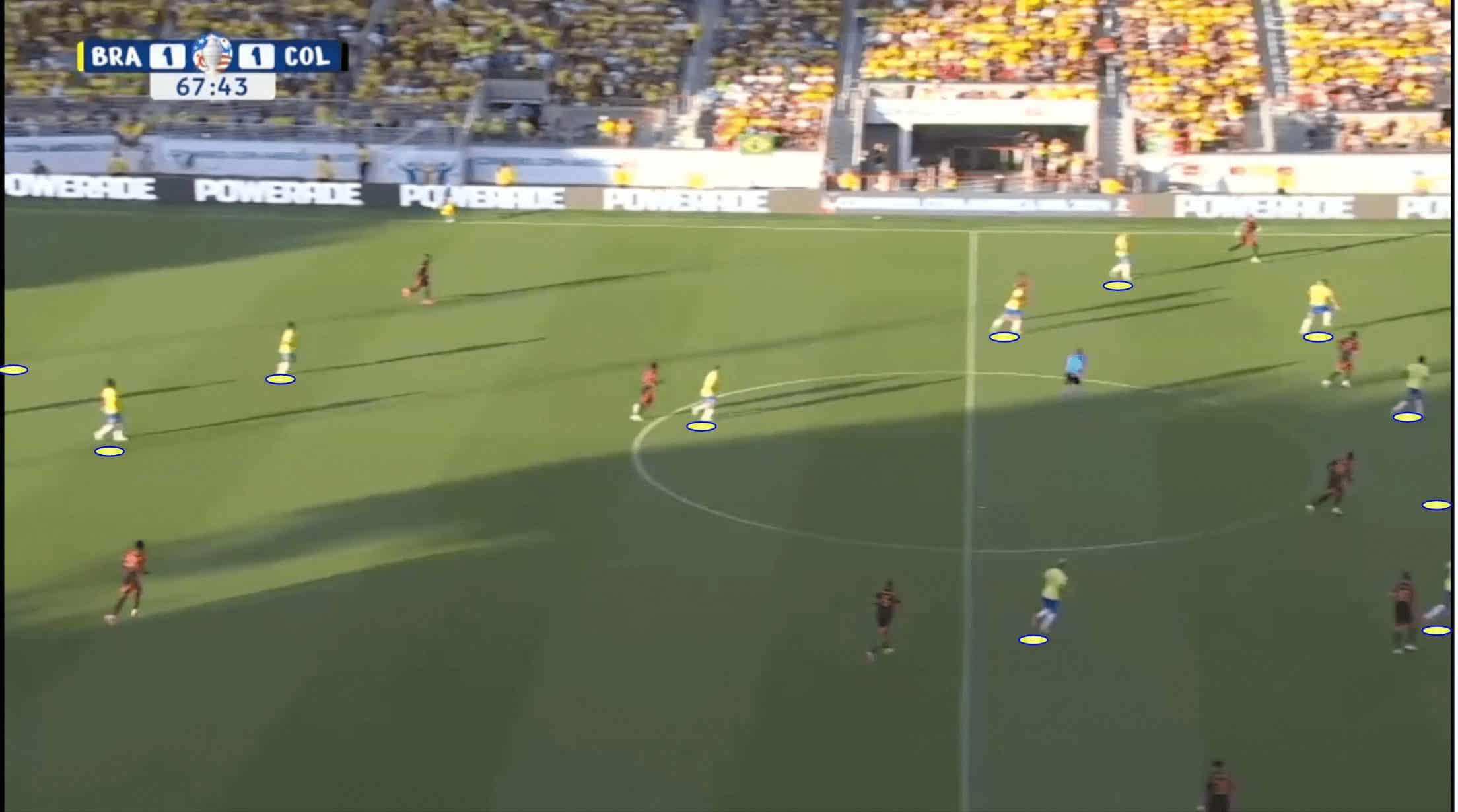
Colombia are happy to play the ball long from the back more than Argentina — this is supported by the fact that Colombia stopper Vargas has played 8.02 long passes per 90 to Argentina ‘keeper Martínez’s 3.68.
They will still play it short at times too, and on those occasions, you’ll see the centre-backs sit narrow on either side of the ‘keeper, with the full-backs a bit more advanced out wide while the central midfielder at the back of the diamond, Ríos, drops in the middle and the other three midfielders in the central four drop into a line of three ahead, creating something of a 2-3-3-2 shape at times though Colombia are extremely fluid with the ball and can’t really be categorised by any particular shape.
When moving into the chance creation phase, Rodríguez will push a bit higher again and he remains high when Colombia play it long from the back as we see in figure 13. He’ll have the forwards ahead on either side of him, with the full-backs overlapping out wide, providing the width for Los Cafeteros’ inside the final third.
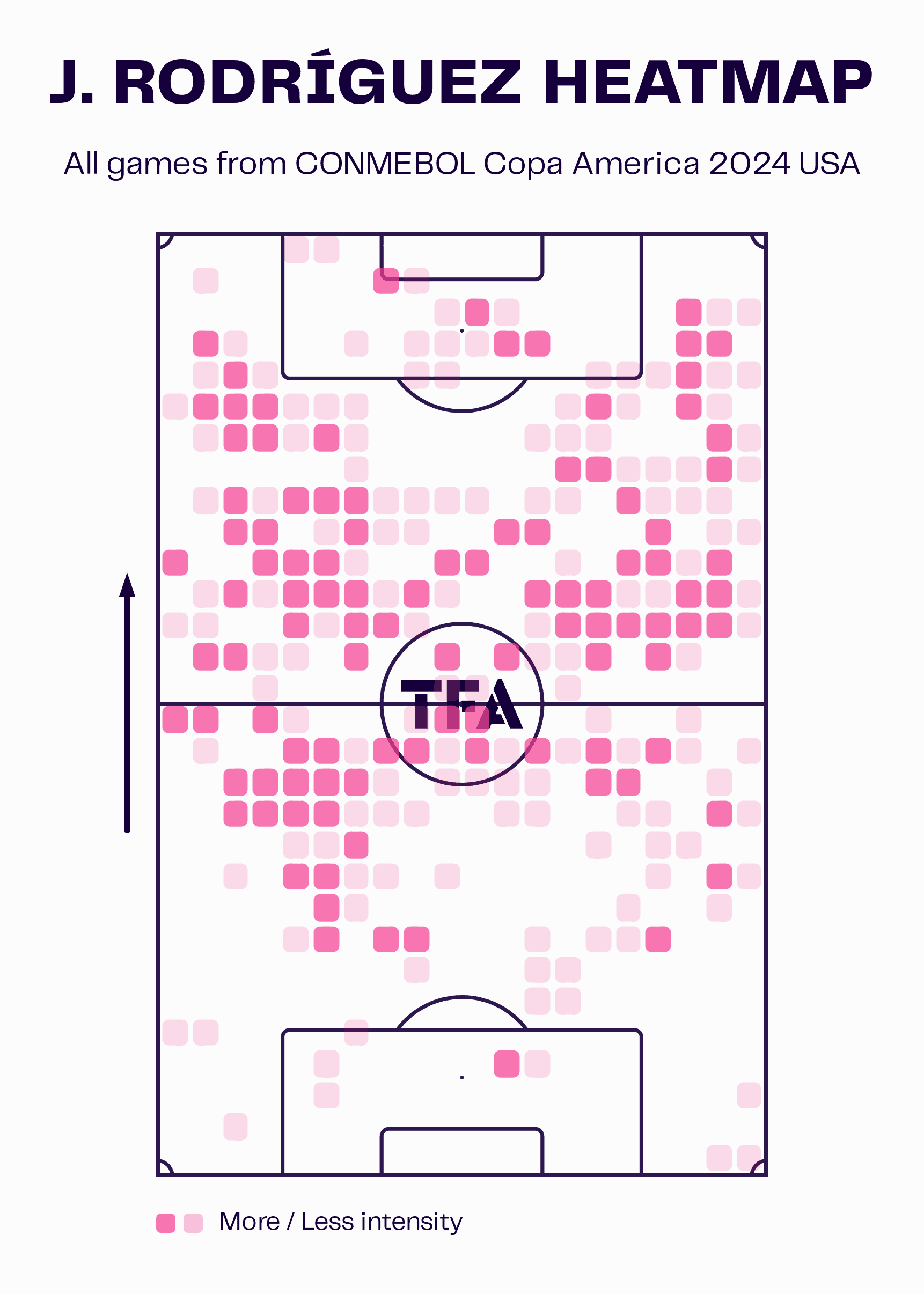
Rodríguez has occasionally popped up on the ball inside the box but generally occupies the half-spaces.
As Colombia’s ‘10’, he enjoys the freedom to drift into the half-space on either side of the pitch, as depicted by his heatmap.
Furthermore, as mentioned, he drops deeper when Colombia try to play out from the back, and this sees him get on the ball inside his team’s half of the pitch plenty of the time as well, turning into more of a deep-lying playmaker and ball progressor than a chance creator.
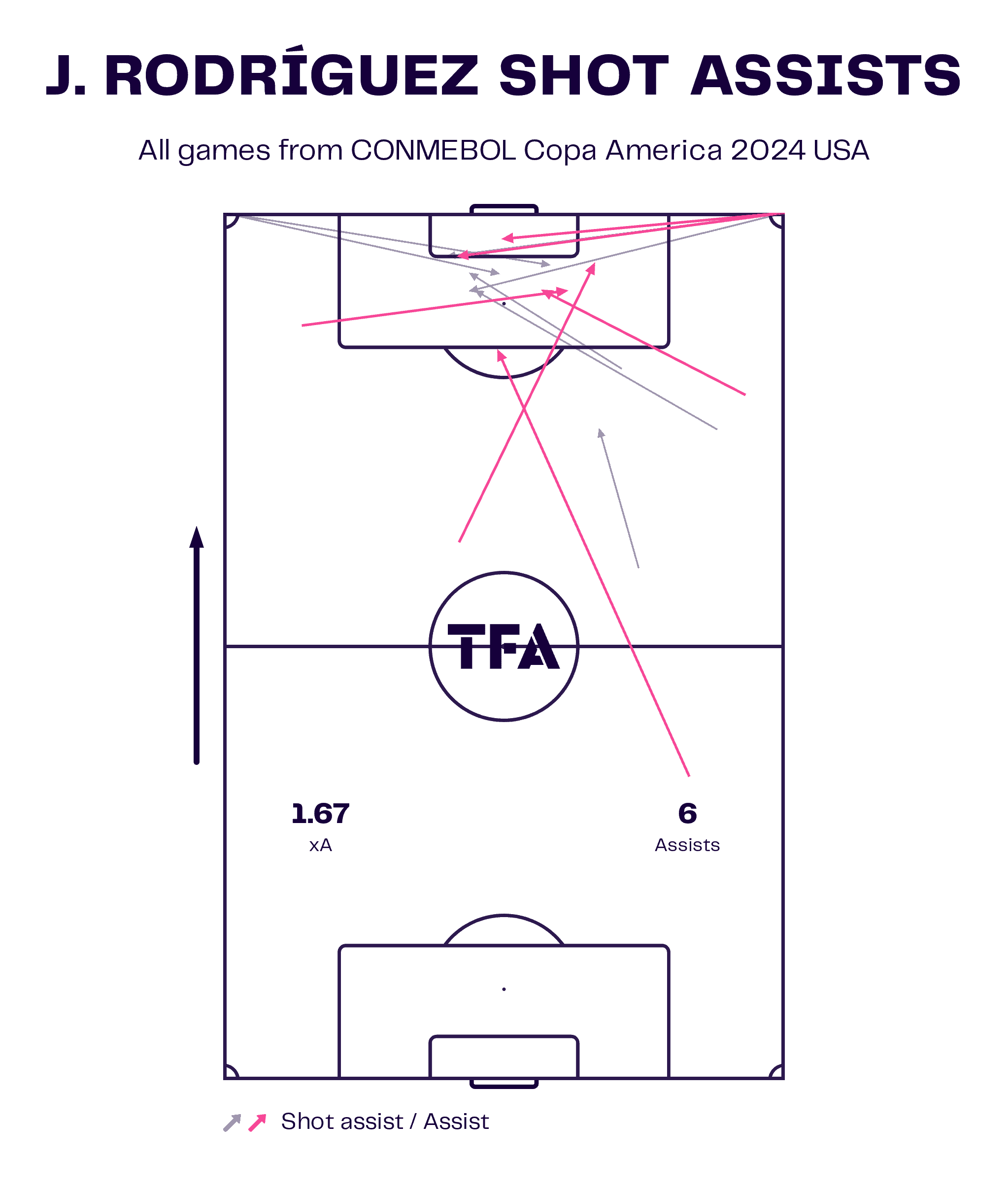
Still, the 33-year-old’s main role during this tournament has been that of an advanced playmaker, which is evident by the location of most of his shot assists, though he has managed to pull off a couple of impressive assists from deep during the tournament.
Additionally, Colombia will threaten Argentina from set-pieces in the final, with Rodríguez assisting five shots and two goals from corner kicks this summer.
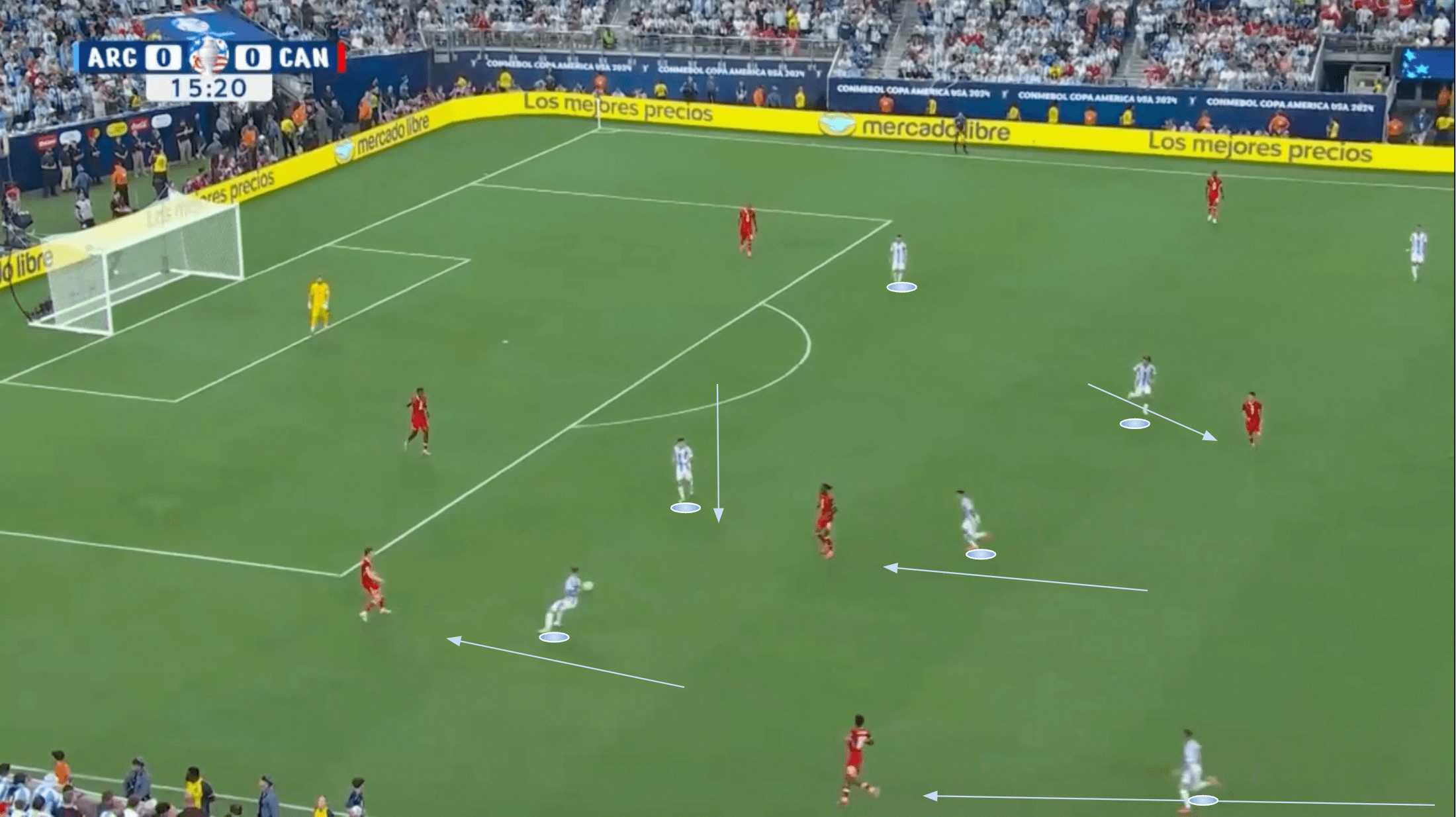
When Colombia try to play out from the back, Argentina will be prepared to press aggressively as you might expect.
They transition to a 4-4-2 without the ball and create something of a six-man cage around the opposition’s midfield, with the strikers covering the passing lanes from centre-back-central midfield, thus forcing the opposition out wide, the wingers pressing aggressively as the ball moves out wide while keeping the advanced pass up the wing blocked off, forcing the ball inside into a central pressing trap with the centre-forward, winger and advancing central midfielder forming a triangle around the receiver to deny them time and space to do much with the ball.
These tactics have been quite common from Argentina throughout the tournament in the defensive phases and have led to plenty of turnovers, either high as a direct result of this pressing trap leading to a successful defensive duel or lower as this press can force a rushed, inaccurate ball forward from the receiver.
Colombia will likely go long quite a bit from the back in the final, hoping to win second balls in the middle third and using their counterpressing prowess to advance forward from there, which could prove quite effective and should result in some intriguing midfield battles.
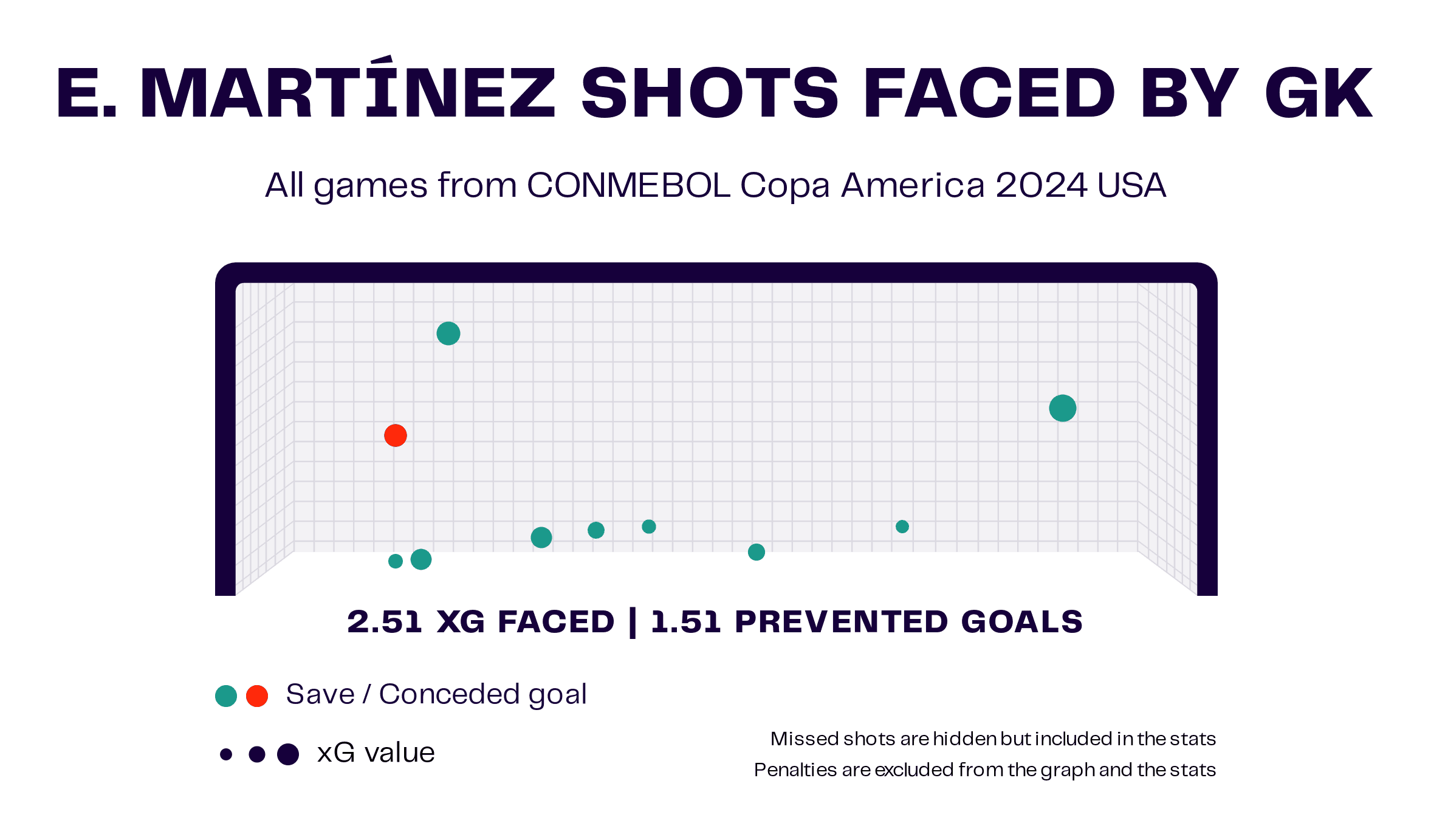
Lastly, as for Argentina’s last line of defence, Emiliano Martínez has been in greater form than his Colombian counterpart during this tournament, impressively preventing 1.51 goals based on xG faced, conceding just once at Copa América this summer.
Both in penalty shootouts and in regular gameplay, the Aston Villa stopper is a major asset for his side and will present a difficult obstacle for Colombia’s forwards to overcome.
Conclusion
Neither of these sides has been kept goalless in any Copa América 2024 game so far, and we do see goals coming in the final, too.
Argentina are stronger in possession, both sides have significant strengths in transitions. While neither are particularly weak without the ball either, with Colombia perhaps edging the open play defence but, Argentina having their net protected by a stronger ‘keeper.
If we were forced to make a prediction, we’d probably have Argentina edging this one, but it’s far from a foregone conclusion.
The key tactical battles should emerge as the battles for second balls from Colombian goal kicks, Argentina’s full-backs in possession versus Colombia’s wide midfielders out of possession, and who can generate the most threat from counterpressing situations.





Comments